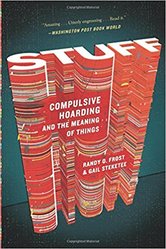 I recently published a review of Buried in Treasures, Help for Compulsive Acquiring, Saving, and Hoarding, by David Tolin, Randy O. Frost and Gail Steketee, a hands-on workbook for those struggling with hoarding and disorganization. What led me to that book was a book I’d read a few weeks earlier, Stuff, Compulsive Hoarding and the Meaning of Things, by Randy O. Frost and Gail Steketee, two of the same authors. As a psychotherapist, I’m fascinated by all different types of minds, and differing ways of looking at the world. Hoarding, with its emphasis on and connection to the world of objects rather than other people, is one such difference. Where Buried in Treasures is a problem-solving Cognitive Behavioral workbook, Stuff reads more like a novel. Its pages are peopled with the author’s examples of different type of hoarders, those who collect antiques, or animals, or even garbage. The authors present some data and facts, as well as theories and their own ideas about what drives hoarders. There is a chapter toward the end on getting help. But the true allure of this fascinating book is the chance to get to know the characters its written about. Although the authors present their own theories on what drives these individuals, you’ll see them in such detail you can come up with your own ideas and even see the ways we all have our own attachments to objects and our own hoarding-like behaviors. Hoarding may be an extreme behavior, but after reading this book, you'll think twice about the next grocery bag you save or the stack of mail on the front table. 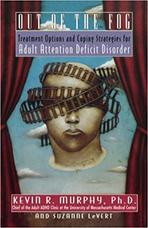 So much of what’s written about ADHD is aimed at parents. But the disorder doesn’t just disappear when these kids grow up. Based on information published on Russell Barkley’s website, 65 to 80% of children with the disorder continue to have impairments as adults. This can range from school, employment, and interpersonal issues to conditions as severe as mental illness, substance abuse and legal problems. I’ve published several good reviews on coping with ADHD in this blog. Smart But Scattered and Late, Lost and Unprepared are two favorites. Although they tend to focus on children’s issues, many of the technique can be adapted to adults. But it’s always best to be able to find something uniquely adapted to your own situation, which is why I was to pleased to find Out of the Fog, Treatment Options and Coping Strategies for Adult Attention Deficit Disorder, by Kevin R, Murphy, Ph.D. and Suzanne LeVert. Dr. Murphy was a researcher at the Adult ADHD Clinic at the University of Massachusetts, and is now in private practice. Out of the Fog is a book that really attempts to do it all: explain the condition of Adult ADHD, discuss treatments and strategies, and cover practical aspects such as organization and communication. With a lesser author, this approach might be too much at cover, but Murphy is so knowledgeable, he’s got good advice for all these varied aspects. Because the book was written in 1995, it doesn’t use some of the newer terminology, such as “Executive Function”, and the specific medication information is showing its age. In general though, the information in this practical guide is still useful and timely. 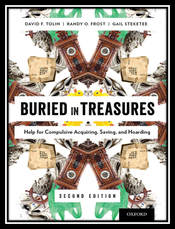 Hoarding is not a disorder that exists only among those on the autism spectrum, but certainly there can be a strong aspect of clutter and disorganization that goes along with Asperger’s, autism, ADHD and the accompanying deficits in executive function. Hoarding at its most severe really requires the help of a specifically trained mental health professional, because it’s about so much more than getting organized and cleaning things up. But for those who won’t, or can’t, access professional help, Buried in Treasures, Help for Compulsive Acquiring, Saving, and Hoarding, by David Tolin, Randy O. Frost and Gail Steketee can be the next best thing. This book, written by a team of experts on Anxiety Disorders, OCD (Obsessive Compulsive Disorder) and hoarding, functions as a step by step guide to solving the problem. Heavily influenced by CBT (Cognitive Behavioral Therapy) techniques as well as practical advice, the book leads the reader through exactly what to do to solve the problems. The focus of the program isn’t just on organizing and throwing things out, it really delves into managing the underlying dysfunctional thinking and erroneous beliefs that can make a hoarding problem so difficult to get a handle on. The authors present numerous specific suggestions for testing beliefs and developing new ways of thinking about objects. In addition to the step by step instructions, Buried in Treasures includes questionnaires, quizzes and worksheets, so the reader can figure out exactly what specific issues are most difficult for him or her to deal with. There are also separate sections with information to assist family members, organizers, and coaches in working with hoarders. This book is a practical hands-on guide that will be useful throughout any stage of the process of dealing with acquiring, clutter, disorganization, and hoarding. 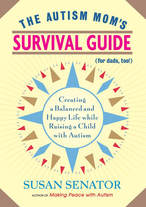 A while back, someone sent me a copy of Susan Senator’s The Autism Mom’s Survival Guide. Susan Senator is a gifted writer, with a blog as well as an earlier book about raising her autistic son. Susan Senator writes with a personal, honest voice that feels like you’re talking with a close friend over a cup of tea. Although I read the book immediately, and keep recommending it to friends and clients, somehow I’ve never reviewed it for my blog. I thought now would be a good time to rectify that lapse. The Autism Mom’s Survival Guide is really all about taking care of yourself at the same time you’re taking care of your special needs child, as well as the rest of your family. Senator writes from her own perspective, as well as compiling the advice of other autism parents. For parents who may feel like they’re all alone, judged by others and not measuring up, this voice from a community of others in the same situation can be a valuable support. My favorite part of the book comes when Senator writes in her own voice, as the mother of a now grown autistic child. Her compassion as she looks back on her own young self, raising her small child, was touching, and just what every young mother needs to hear. This book is a gift for all parents of special needs kids, a book to pull out when you feel like no one understands, or that you’re all alone. 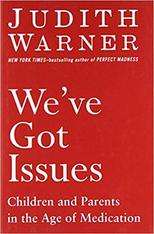 Are kids today over-medicated and over-diagnosed by their hovering helicopter parents? Or, is all the medication and treatment necessary to help kids manage their very real mental disorders? Those are the questions Judith Warner addresses in We’ve Got Issues: Children and Parents in the Age of Medication. As Warner explains, she started writing this book based on the premise that today’s kids are over-medicated and over-diagnosed, but as she continued her research, she decided that the media and it’s anecdotal evidence were oversimplifying the picture. As an engineer, I love that Warner actually researched the topic, and allowed the evidence to influence her thinking. I also appreciated that she has such an extensive reference list, over 50 pages for those who want to learn more. As a reader, I appreciated the well written style of the book. But, as a therapist, I thought the conclusions were too simply stated, and the conversational, anecdotal tone was relied on so much it interfered with a more rigorous analysis. Surely, the truth lies somewhere in the middle. Some parents hover, expect too much from their kids, and pathologize normal behavior. Other parents, certainly the overwhelming majority of the families I’ve seen, are dealing with kids who are clearly struggling, kids who have evident difficulties, and their parents allow medication and diagnosis only with caution and reluctance. But the way to illustrate this truth is through facts and data, and too often Warner relies on examples and stories from the families she’s interviewed. A compelling read, no doubt, but ironic in that Warner is criticizing the very type of research-by-anecdotal-evidence that she’s using here. Warner also criticizes the mental health treatment in our country, and I don’t think anyone would argue with her. But she illustrates her thesis with a series of examples from many of the families she’s met, who told of shoddy treatment and erroneous diagnosis. Warner complains because there’s no clear path for parents to take, and they end up “wandering in the dark forest, without a compass, as they tried to figure out how to help their son.” Again, although I agree with Warner’s concerns, it’s a sad truth that mental illness and its treatment is so complex that there’s often more art than science involved. The best treatment may involve uncertain diagnoses, trial therapies, and a great deal of uncertainty. There may not be a clear path. Still, I’m including this book on my blog list because, in spite of its shortcomings, it is a worthwhile and interesting read. With its extensive reference list there’s plenty of material so you can take your own understanding to a much deeper level. 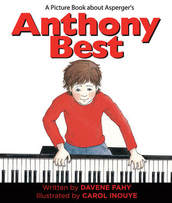 One of the hardest parts about the autism spectrum can be the feeling of separation it brings about. Adults on the spectrum may feel isolated and different than other people they live and work with. Parents of autistic kids can feel judged and criticized by other parents, especially those with easy children. Probably most difficult is the children on the spectrum, who often suffer through teasing, bullying or just being left out. I think sometimes this isolation can be toughest for kids in mainstream schools, where their academic abilities are strong, but their social skills keep them from connecting with classmates. So often, the typical kids don’t understand what’s different about their autistic classmates and neighbors, so they might view autistic behaviors as mean or unfriendly. And the sad result is that the autistic kids get left out. Education and communication can go a long way toward creating understanding, and books can be the best way to start that conversation. One sweet picture book I recently read is Anthony Best by Davene Fahy. In this simple book, Fahy explores the relationship between Anthony, a child on the autism spectrum, and his neighbor Hannah. The book illustrates many of the behaviors that might be puzzling or upsetting to neurotypical children, such as stimming behaviors, lack of eye contact, and communication differences. These behaviors are presented in a simple, non-judging way, which leaves plenty of space to have a conversation with young readers. If you have a child on the spectrum, or with behavioral or learning differences, this book could be a good choice to present to neighbors or friends who want their children to learn a bit more about how differences don’t have to keep kids from being friends. And, Anthony Best would be a nice book for any teacher to have in the classroom. 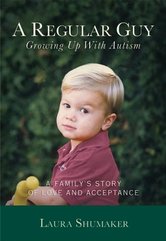 The Autism Spectrum is so broad, the gifts and difficulties so varied, that people often tell me about how they feel alone, that their experiences are different than others, and no one understands what they’re going through. And, for those raising a child on the spectrum, there are ongoing challenges that can feel very isolating for parents as well as kids. It starts with noticing something concerning about a child, then moves to dealing with the medical professionals, getting the right diagnosis, finding the right services and the appropriate educational setting. Sadly, the typical world can be a harsh and judging critic along the way. And the difficulties don’t end in adulthood, because often special needs adults need individualized plans to ensure appropriate employment and living situations. Because each child is so different, it’s not a one size fits all situation. That’s one way that books and blogs can be vital, as the link connecting individuals, showing people that they’re not alone and others might be going through a very similar struggle. A Regular Guy: Growing up with Autism , by Laura Shumaker is an excellent example of a book that helps create that connection for parents raising kids with special needs. Shumaker chronicles her struggles with the medical profession, helping her son find the right school setting, and to fit in with neighbors and friends. She’s honest about her family’s struggles, and compassionately attuned to the pain her son goes through as well. The hardest parts of the book are those describing the many tough decisions Shumaker is forced to make, often for her son’s own good, but also hard for him to accept. I recommend this insightful book for any parent dealing with those tough choices, and anyone feeling isolated or judged by their parenting situation. 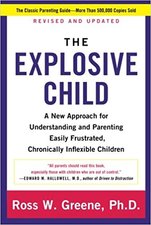 You do everything the experts advise. You set up rules and rewards and consequences and you’re as consistent as possible. But still, your child melts down, throws a tantrum in front of everyone, screams and yells, and you’re left embarrassed, judged, angry, and thinking that you don’t know what you’re doing. Maybe it’s not that you’re doing anything wrong. Kids with special needs can be difficult to parent. So often, well meaning - or maybe just nosy - friends, relatives and even your own parents may not understand it. “If you’d only…, be tougher, be less tough, do what we do, whatever,...your child would be as well behaved as mine.” But that advice only works for their children. It may not work for yours. The Explosive Child: A New Approach for Understanding and Parenting Easily Frustrated, Chronically Inflexible Children, by Ross W. Greene, Ph.D. may be exactly the help your family needs. Greene presents a different theory behind the meltdowns, the idea that children behave well when they can. And when they don’t manage to hold things together, through tantrums and worse, it’s not that these children don’t know right from wrong, or that they don’t know that their parents are the boss. Kids throw tantrums because they don’t have the skills to behave better. Greene posits that weaknesses in “flexibility and frustration tolerance” can trigger these meltdowns. These “pathways” to meltdown include “executive skills, language processing skills, emotion regulation skills, cognitive flexibility skills, and social skills.” That’s a pretty complete list of what a lot of children with ASDs or ADHD may be struggling with. And, the “triggers” to these tantrums are probably pretty predictable as well. Further, Greene states that continuing to fight, struggle, set a line in the sand, put your foot down, can be just doing more of what wasn’t working in the first place. Greene’s plan involves moving beyond the extremes that parents often choose: either insisting on the adult’s way (Greene terms this Plan A) or giving in to the child (Plan C) to a Plan B, involving collaborative problem solving. In collaborative problem solving, the parent is really functioning as a “surrogate frontal lobe” and helping the child develop those skills necessary to manage tough situations. Greene looks at triggers to explosions, and develops plans to be proactive in avoiding meltdowns, as well as coming up with quick emergency plans for when explosions are about to happen. Of course, every child is different, and it’s difficult to fit an individual, or a family, into a prewritten book. But Greene give numerous examples, asks some tough questions, and really helps the reader envision how this different way of looking at parenting challenging kids may be the answer. His writing is so clear and methodical that it easily moves the frustration of parenting into a logical, problem solving arena. I encourage parents to read this book carefully, think about your own family dynamics, and try these techniques out for your own family. 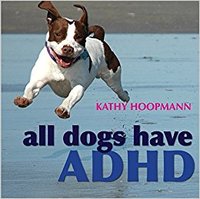 Many parents worry about labeling their child, stigmatizing them, or excusing behavior problems, if they tell their child that he or she has a diagnosis of Asperger’s, autism, or ADHD. I’ve found just the opposite. Kids know that they are getting in trouble in school, they know that other kids seem to have an easier time with following the rules or making friends, but without knowing about their own diagnosis, they just think that they’re bad or stupid. To me, that seems so unfair! I firmly believe that parents should tell their kids, in an age appropriate way, of course, about their diagnosis, and the strengths and difficulties that go along with that diagnosis. Books are a great way to enhance a conversation about your child’s diagnosis. For kids with ADHD, All Dogs Have ADHD, by Kathy Hoopman is a fun and positive option. The book is a simple read, with cute pictures of dogs, and nicely presented, non-judging comments about behaviors and symptoms. Problems are presented realistically, such as social issues or difficulties with following directions, but the book also presents the energy and fun that can make kids with ADHD such a joy to be with. 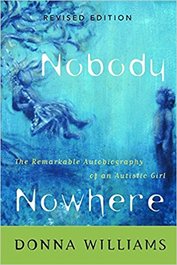 The joy of reading is how it allows us all to experience the world from within another’s perspective. When an autobiography is authentic and genuine, the reader can immerse in the writer’s reality. Nobody Nowhere: The Extraordinary Autobiography of an Autistic, by Donna Williams, is one of those books. Alternately engaging and informative, as well as confusing and disturbing, Nobody Nowhere pulls its readers into Donna Williams’ world. Published in 1992, the book is certainly out of date in some ways, particularly the more technical aspects surrounding the diagnosis. (The author has published a number of books since this, her first, and, although I haven’t read them, I would imagine they’re more accurate and up to date with more current knowledge about the condition.) The more timeless aspects of the book are the more personal, where Williams relates her own experiences, her connection to things rather than people, her struggles to feel safe and also to connect. Often the book feels disjointed and confusing, in part because of the unclear timelines, as well as the author’s habit of referring to herself by various names and in the third person. Rather than detract from the book, this confusion adds to the experiential nature of the book, although it can be disturbing to read of the abuse and mistreatment the author endured. The final section of the book presents the author’s own theories about autism as well as her suggestions for communicating with autistic children. Of course, the autism spectrum is very broad, but especially for parents looking to understand their own child, Williams’ suggestions may provide some valuable insights. |
Patricia Robinson MFT
I'm a licensed therapist in Danville, California and a coach for Asperger's and ADHD nationwide. I work with individuals of all ages who have special needs, like Autism Spectrum Disorders, ADD, ADHD, and the family members and partners of special needs individuals. Archives
February 2015
Categories
All
|
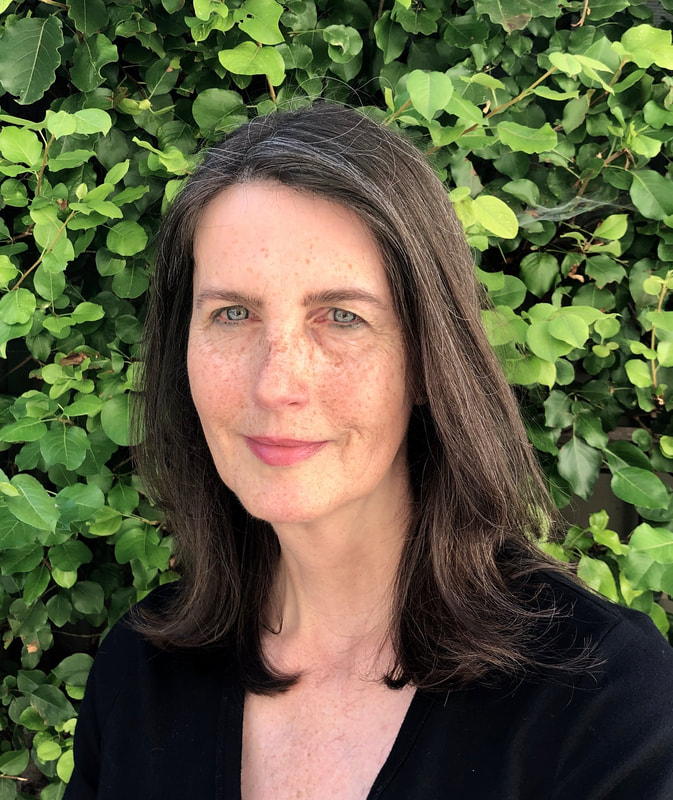
 RSS Feed
RSS Feed